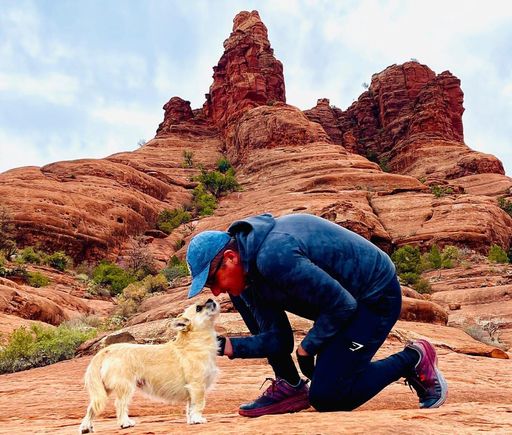Hiking or backpacking is a great way to keep in shape and to enjoy the fresh air and the Great Outdoors. So, why not multitask and exercise your dog at the same time?
That sounds like a good plan, but there are some important considerations to bear in mind before you lace up your hiking boots and put on Fido’s lead.
How Fit Is Your Dog?
Before you hit the trails, take a good look at your pet. Is your dog fit enough to accompany you on hiking trips?
Some dogs are simply not physically able to cope with prolonged periods of walking, especially over challenging terrain. It’s basically a case of “horses for courses.”
For example, brachycephalic dogs, such as pugs and bulldogs, can experience breathing problems, especially in hot weather. That leads to overheating and dangerous levels of physical stress. Small dogs with short legs, such as terriers or dachshunds, will obviously have trouble matching strides with you, whilst heavy breeds with long, thick coats like Newfoundlands will struggle to keep cool in warm weather and can easily develop heatstroke and dehydration.
Senior Dogs
You also need to consider the age of your dog.
Just as you wouldn’t expect your 90-year-old mom to accompany you on a ten-mile hike up into the mountains, you can’t ask your 12-year-old German Shepherd to do so either, no matter how keen he seems at the start! The same goes for puppies; they may be full of beans when you set off, but just like children, they’ll soon tire, and lasting physical damage can be done if you overdo things.
If you’re into hiking or backpacking over long distances and you don’t want to stop for frequent breaks, then taking your dog with you is probably not going to be practical. If you’re in any doubt about your dog’s physical suitability for what you have in mind, always consult your vet before you plan your trip.
What Equipment Do You Need?
You’ll have a good-quality pair of walking boots, a backpack, and suitable clothing for hiking. But don’t forget your pooch; he needs to be correctly equipped for the trip, too!
Harness And Leash
Your dog will need to wear a collar with his ID tags attached to it, as well as a rabies vaccination tab if that’s applicable for the area you’re intending to go hiking in. But don’t have your dog’s lead attached directly to his collar, and never use a choke chain! Opt instead for a comfy, correctly fitted harness that won’t chafe or rub your dog’s skin.
Footwear
Some dogs with sensitive pads can suffer from injuries caused by moving over rough, stony surfaces and might benefit from wearing special dog boots.
Dog boots are lightweight, easy to fit, and durable, and they’re also considerably cheaper than vet’s bills! Although some dogs take a while to get used to the unfamiliar feeling of a set of boots, most soon adapt.
Water
When it’s warm, your dog will need to be kept hydrated; just like you!
Lightweight, portable, folding dog bowls are available that you can fill from your water bottle.
Clean Up!
Don’t forget to take a supply of poop bags, too, just in case! Many trails and parks have plenty of dog waste bins situated along the way where you can dispose of dirty bags.
Conditioning Work For Your Dog
If your dog is not used to walking for long distances, you will need to do some interval training to get him fit. Gradually increase the distance you cover, observing your dog closely to make sure he’s coping.
You’ll both enjoy yourselves much more if your dog is fit enough to keep up, and you’ll also avoid injuries. Breaks are important, even when your dog is fully up-to-speed. Remember too, that dogs like to sniff around and relieve themselves frequently, so make sure you allow your pet ample time to do so.
Discipline
No dog is perfect, regardless of how much time you spend training him, so always carry a leash with you, even if you usually don’t use one.
Your dog should be trained to walk obediently to heel, and you should always keep him on a leash in areas where you are likely to encounter other walkers, runners, cyclists, and dogs. A distraction, such as your dog’s favorite pull toy, can be a good way of keeping your pup’s focus in challenging situations.
Remember, too, that not all state parks and wilderness areas allow dogs, and most have strict leash rules. So, be sure to check what’s permitted before you go.
Know When Enough Is Enough
When setting off for a summer backpacking or hiking expedition with your furry friend, it’s important to remember that dogs do not tolerate heat very well.
Dogs can’t sweat readily and, instead, lose heat by panting. If your dog appears alert with pricked ears and is panting quietly with his tongue completely inside his mouth, he’s fine. However, if your pet’s tongue is hanging out completely, his mouth is wide open, and the sides of his mouth are pulled right back, your dog is overheating, and you must stop, allow him to rest, and offer him a drink.
Your dog’s breathing should return to normal within a few minutes, but if it doesn’t, call it quits for the day. When your dog has had enough, he might slow down and lag behind you. Never keep pushing your pet until he has to lie down, and always stop and rest if your pooch begins limping.
In Conclusion
Hiking or backpacking with your dog is a great fun way to enjoy the outdoors and stay in shape.
Before you plan your trip, make sure that your dog will be fit and healthy enough to keep up with you and enjoy himself without struggling. If you’re in any doubt about your dog’s suitability for a hiking trip, always ask your vet for advice.
Happy hiking!



















